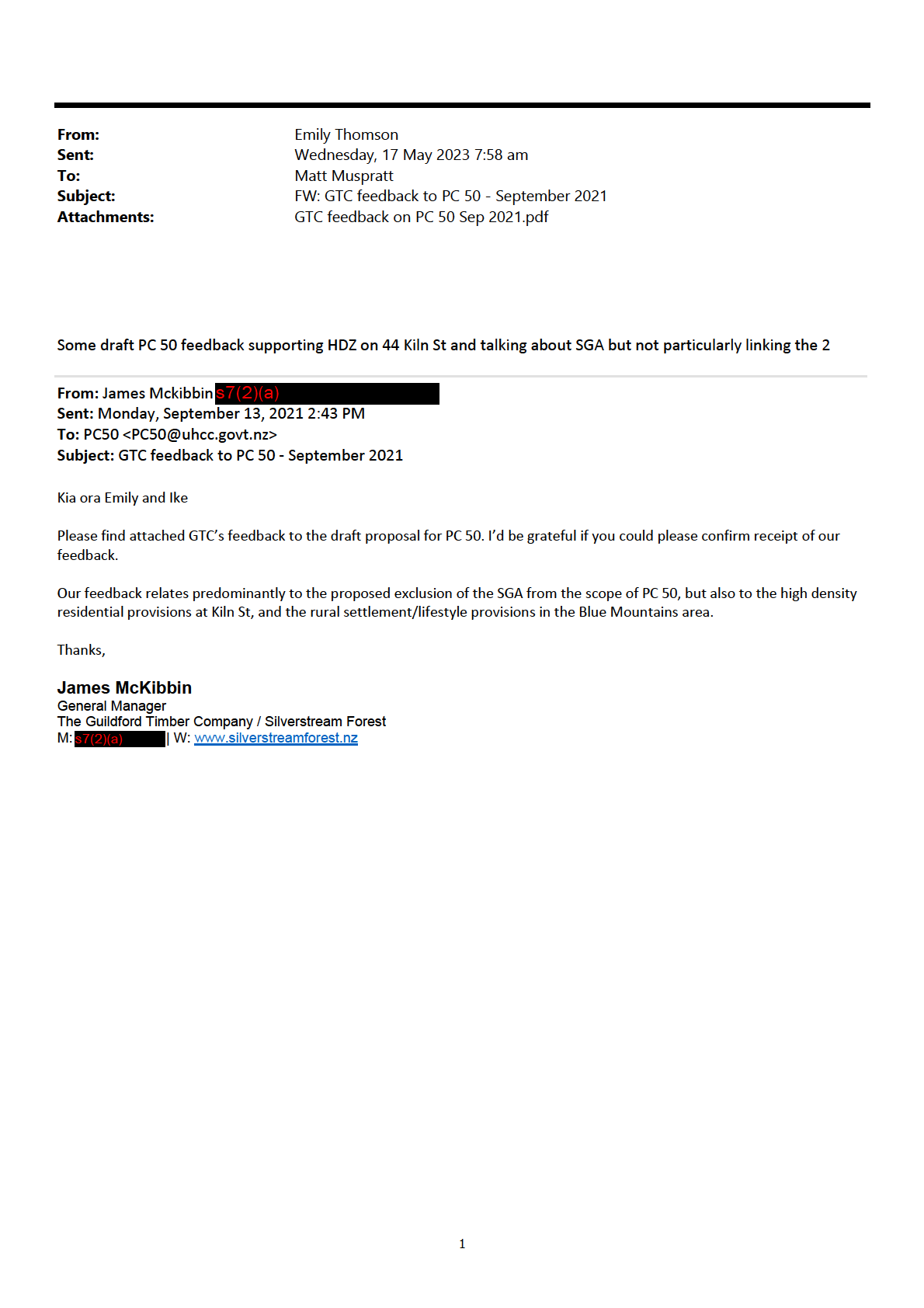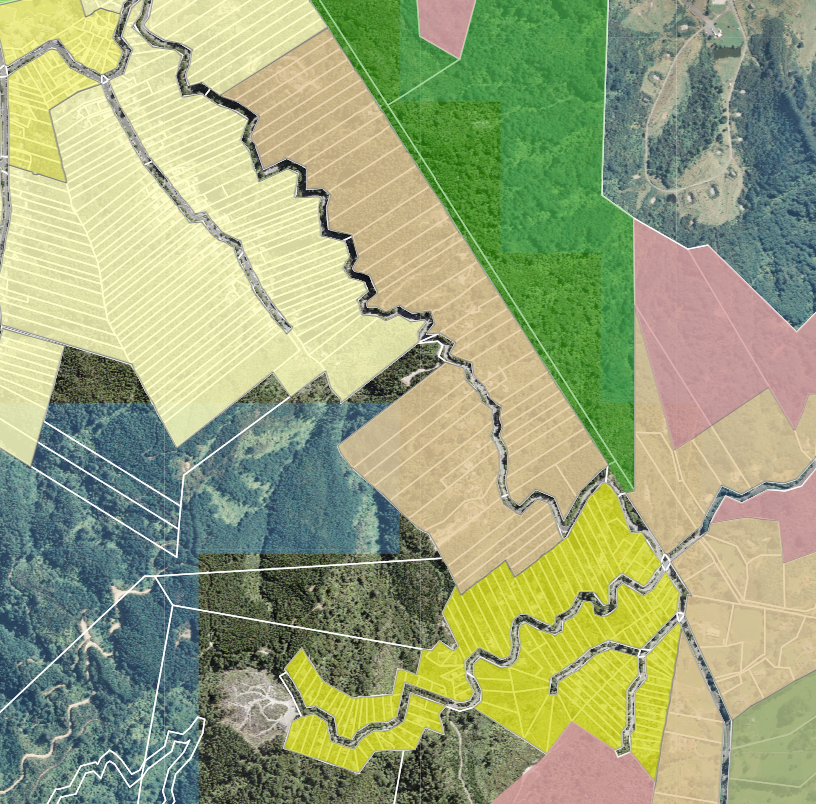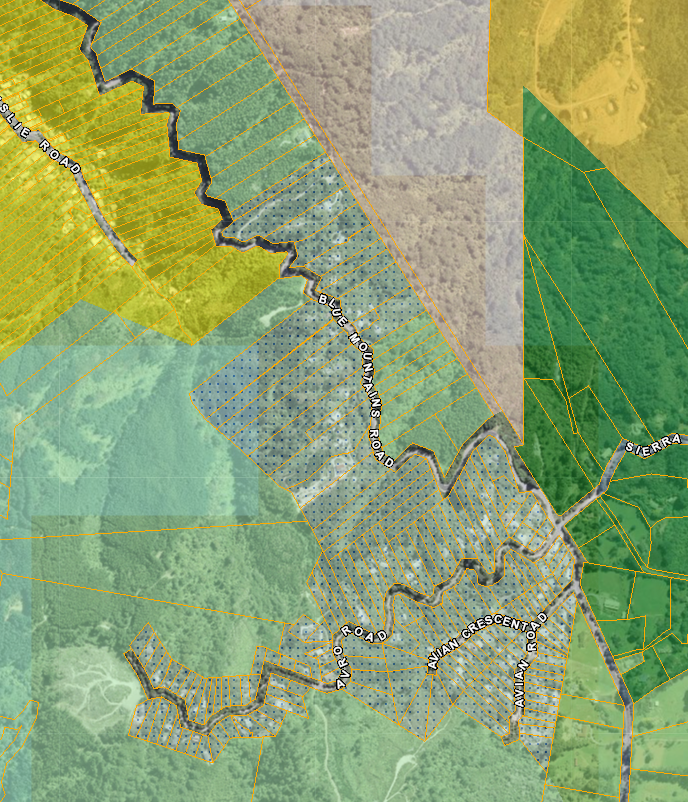
Draft proposal for the Rural and Residential Chapters
Review
Plan Change 50 of the Upper Hutt District Plan
Feedback from The Guildford Timber Company Ltd.
Monday 13 September 2021.
___________________________________________________________________________
1
Introduction
The Guildford Timber Company (GTC) is grateful for the opportunity to provide feedback to
the Upper Hutt City Council (Council) on its draft proposal for Plan Change 50 (PC 50).
PC 50 is a critical piece of work and GTC wishes to acknowledge the staff and Council for
their hard work over the last couple of years on getting to this point.
Upper Hutt, like other cities, is facing unprecedented growth. This is evidenced by the
results of the review of the Housing and Business Capacity Assessment (HBA), which Council
has signaled wil show that 10,000 homes wil need to be built in the long term – not 5,600
as projected in 2019.
GTC owns Silverstream Forest – more than 300ha at the southern end of the city. This land
has been identified as the ‘Southern Growth Area’ (SGA) in Upper Hutt; one of a number of
strategic growth areas identified in the Council’s Land Use Strategy and the Wel ington
Regional Growth Framework. GTC has completed a conceptual masterplan for Silverstream
Forest, which at this stage shows the site could potentially provide up to 1600 homes.
Silverstream Forest has the potential to make a significant contribution to Upper Hutt’s
future housing supply.
PC 50’s urban objectives have a clear focus on the diversity of housing, sustainable urban
design and climate resilience. GTC shares these objectives and they are reflected in the
masterplan for Silverstream Forest.
GTC owns a number of other titles subject to the zone changes proposed by PC 50, and
these are commented on separately in our feedback.
We have not taken the opportunity to explain the company’s history to the area, as this has
been covered in previous submissions to the Council and explained in detail on our website
at www.silverstreamforest.nz
1
2
Silverstream Forest / the Southern Growth Area
As explained in the PC 50 FAQs, “PC 50 is not proposing to rezone the Silverstream Spur or
the Southern Growth Area” for the reason stated that “There has not been sufficient
supporting information provided by the landowners to consider these growth areas through
PC 50”. The FAQs then state that “Therefore the Southern Growth Area and Silverstream
Spur is proposed to be considered through a separate Council-initiated plan change process
once sufficient information has been made available to support the plan change”.
While GTC appreciates Council’s intention to initiate a separate plan change when it has
sufficient information to do so, GTC believes that expressly excluding the SGA from PC 50 is
a poor outcome for several reasons.
The review of the HBA shows that projected growth is far higher than predicted in the 2019
assessment and the city now needs to provide for 10,000 homes in the long-term, rather
than 5,600. We would value seeing more information about the assumptions Council is
making regarding the uptake of high-density development to provide for this growth in the
long-term. While we support higher density infil development in principle, we are conscious
that both infil and greenfield development wil be needed in order to bring on the number
of homes at the required rates over the next 30 years.
GTC does not consider that insufficient supporting information provided by GTC be a reason
to exclude the Southern Growth Area from inclusion in the plan change. Gil espies Road is
identified as a proposed Future Urban Zone, and under the proposed provisions residential
development cannot occur there until:
• Roading design provides multiple connections to the Gil espies Block
• There is the ability to service the site by three waters infrastructure
• A comprehensive structure plan has been developed; and
• The area has been rezoned
There are further requirements including reducing greenhouse gas emissions, integrating
public and active transport options, maximizing density to make efficient use of land, and
on-site measures be put in place to reduce dependency on network utility infrastructure.
GTC does not see why the same approach isn’t being adopted for the Southern Growth
Area?
GTC appreciates the response that officers have provided about ‘legalistic’ reasons why
Council is not proposing to include the SGA in the scope of PC 50 or zone the SGA ‘Future
Urban’.
These included:
• That the scale of PC 50 means it is likely to take some time to complete, meaning there
is a chance that legal effect of an SGA plan change could happen prior to PC obtaining
legal effect, despite PC 50 being notified earlier.
2
• If PC 50 were to propose Future Urban zoning, it would mean that this zoning would
overwrite the outcomes of the SGA plan change, making it nul and void.
• Alternatively, if Future Urban were to be proposed, and a submission(s) were to be
made to enable the SGA, this could force PC 50 to be re-notified through a variation
process, further delaying PC 50 having legal effect.
However, GTC disagrees with the extent of those concerns and has already provided its
reasoning for this to officers for consideration.
GTC’s response was that:
• Regarding the scenario where the SGA is zoned ‘Future Urban Zone’ under PC 50 and a
separate plan change for SGA is advanced in a slightly delayed timeframe, the RMA
provides for the variation process to wash-up any overlap should that occur.
• Regarding the scenario where the SGA is zoned Future Urban Zone under PC 50 and GTC
seek an urban zoning via submission, there is no impediment to this and it wouldn’t
dictate the need for a variation.
• The entirety of PC 50 that survives the submission process without appeal is effectively
operative irrespective of how long it takes to resolve any appeals relating to the SGA or
any other discrete aspect of PC 50.
Excluding the SGA from PC 50 is in conflict with the intent of the NPS-UD to take a
comprehensive approach to providing for future growth, and amounts to a duplication in
cost and process for two urban growth plan changes that should be advanced together. GTC
doesn’t consider this approach as good value for the community, neither in the context of
Council’s fiscal obligations under the LGA, nor in the context of s32 of the RMA.
GTC also notes that recently Council submitted an Expression of Interest for an
infrastructure corridor that wil support growth at Silverstream Forest, to the Government’s
Infrastructure Acceleration Fund. Excluding the SGA from PC 50 seems incongruous with
that decision, as the ability to describe a structured and imminent planning process wil be
essential to the viability of the IAF application.
GTC requests that the Southern Growth Area either be identified as a Future Urban Zone or
live-zoned for residential, community and small-scale commercial activities with appropriate
rules in place around subdivision, land use and development.
3
44 Kiln St (Lot 1 DP 85787)
GTC owns approximately 3ha of land at 44 Kiln St. This has been identified for re-zoning in
the draft proposal to ‘High Density Residential’. Overall, GTC is supportive of this zoning as
the site has potential to make a significant contribution to the residential housing market in
close proximity to the Silverstream shops and its public transport node. The site may lend
itself to partial commercial use alongside residential, and GTC supports the objectives and
policies set out in the draft proposal to provide for this. Namely:
UFD-P18 – Consideration of non-residential activities.
3
HRZ – 03 – Ancil ary and mixed-use development.
HRZ – P4 – Provide for ancil ary services.
GTC is however, concerned with the intent of SUB-RES-P6 ‘Efficient development threshold’
to
require minimum densities on sites able to deliver scale intensification. It is GTC’s view
that requiring a minimum of 50 dwel ings per ha should only be applied where there is clear
and compel ing evidence to support this – which should include a local market assessment
of the commercial feasibility of building to that density. GTC would find it useful to see the
evidential basis for this particular policy. The adjacent Amberley Gardens development is a
comparable site to 44 Kiln Street. Its finished density is closer to 20 dwel ings per hectare,
which represents some of the highest density housing in Upper Hutt. GTC is not aware of
any development approaching a density near 50 dwel ings per hectare in Upper Hutt at
present.
4
Other titles
GTC owns a number of other titles along Blue Mountains Rd, Avro Rd and Avian Crescent
that are subject to proposed changes in zoning.
222-230 Blue Mountains Rd (Lots 265 - 269 DP 9629) are proposed to change from ‘Rural
Hil Blue Mt’ to ‘Rural Lifestyle’. Properties adjacent to these titles along Avro Rd have
instead proposed zoning changes from ‘Rural Hil Blue Mt’ to ‘Settlement Zone’ (refer to
maps 1 and 2 for proposed and current zone extents).
GTC requests that Council considers applying the Settlement Zone to, at least, all titles
currently identified as ‘Rural Hil Blue Mt’ in the current District Plan. GTC also requests that
Council consider applying the ‘Settlement Zone’ along the eastern extent of Blue Mountains
Rd which has been proposed as ‘Rural Lifestyle’. A key purpose of the Settlement Zone is
that it is a transition zone between urban and rural areas and is in close proximity to the
urban perimeter. GTC’s view is that this zoning aligns more closely with the qualities of the
Blue Mountains area than the ‘Rural Lifestyle’ zone, which seeks to achieve more open rural
amenity.
GTC also notes that the layout of titles along Blue Mountains Rd wil not lend themselves to
achieving either the 100m or 150m minimum distance between accessways onto roads.
Council should consider using metrics that are achievable and at least provide for access
separations to reflect the distances ‘on the ground’ currently in these zones. Similarly, to
facilitate logical development Council should incentivize boundary adjustments to enable:
• a more logical layout of allotments
• a more sensitive finished development pattern and / or
• the opportunity to rationalize multiple existing accesses into fewer access points to
enhance the safe, efficient function of the road network.
4
 5
Summary
5
Summary
GTC wishes to thank the Council and staff again for the opportunity to provide feedback on
PC 50. The company appreciates the approach Council has taken by engaging the
community consistently through the development of the plan change.
PC 50 is Council’s opportunity to take a comprehensive approach to the long-term future
growth of Upper Hutt. GTC considers the exclusion of one of the city’s major identified
future growth areas to be at odds with this approach and is seeking Council’s
reconsideration of the Southern Growth Area’s exclusion from PC 50.
GTC would welcome the opportunity to further discuss the views presented in its feedback.
James McKibbin
General Manager, The Guildford Timber Company.
P: 027 372 5560 | E: [email address]
Map 1: Draft proposed zoning – Blue Mountains Rd
5

Map 2: Current District Plan zoning – Blue Mountains Rd
6


